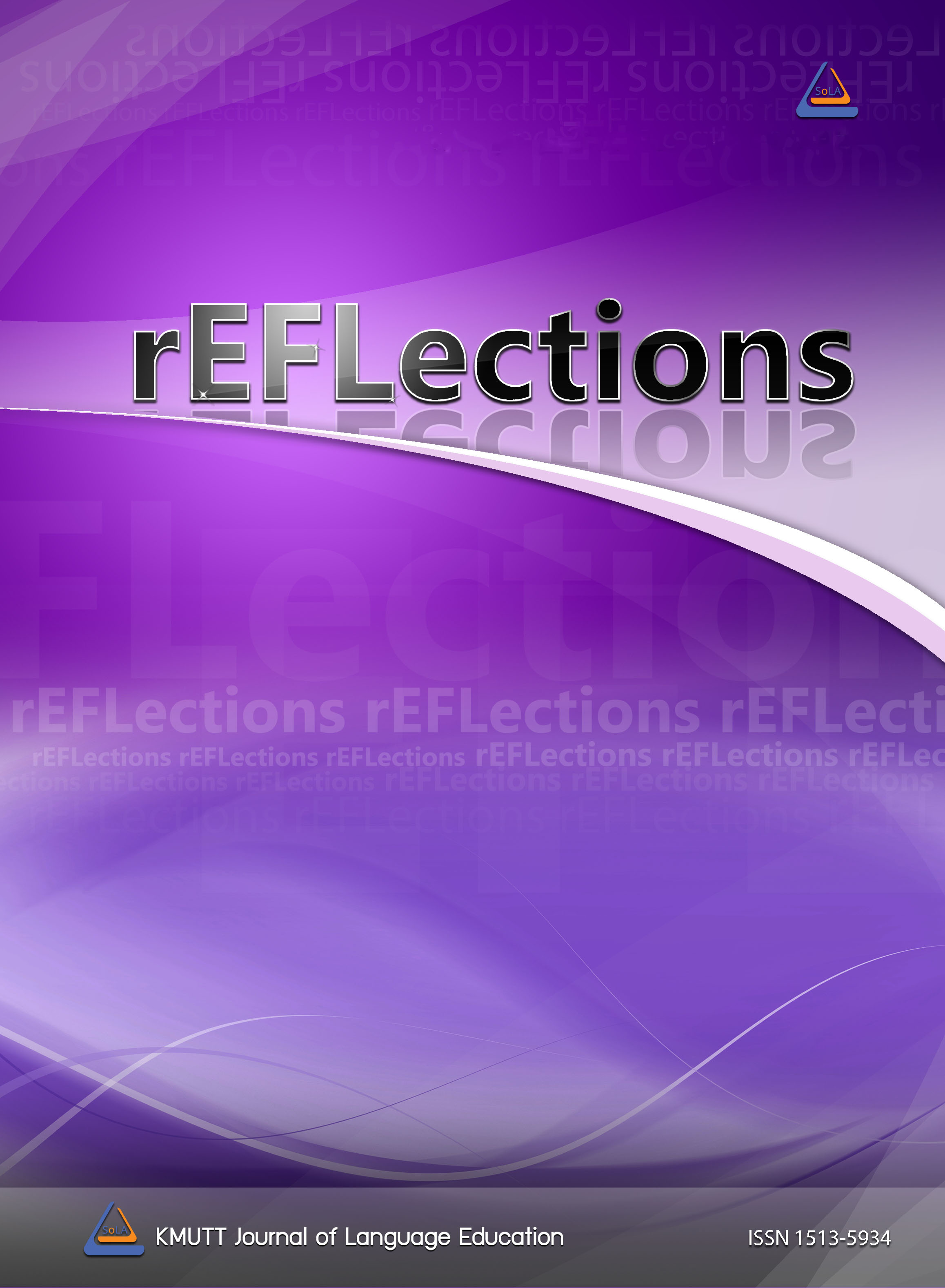Phrasal Complexity Measures as Predictors of EFL University Students’ English Academic Writing Proficiency
Main Article Content
Abstract
The study aims to investigate phrasal complexity measures that can predict EFL students’ academic writing proficiency. Academic English written test responses were derived from written responses from the Khon Kaen University Academic English Language Test (KKU-‐AELT). Five hundred and thirty written responses were separated into groups based on their writing scores. Sixty-‐six phrasal complexity measures (Kyle, 2016) were analyzed for this study. The Tool for the Automatic Analysis of Syntactic Sophistication and Complexity (TAASSC), a computational tool for phrasal complexity analysis, was used to calculate the average numbers of occurring measures in written responses. Phrasal complexity measures occurring in written responses were analyzed with the independent t-‐test. Then, 11 significant phrasal complexity measures, derived from the independent t-‐test, were entered into Binary logistic regression in order to examine potential phrasal complexity measures that can predict proficiency levels. The results revealed three phrasal complexity measures that can predict academic writing for higher proficiency level students.
Article Details
References
Ansarifar, A., Shahriari, H., & Pishghadam, R. (2018). Phrasal complexity in academic writing: A comparison of abstracts written by graduate students and expert writers in applied linguistics. Journal of English for Academic Purposes, 31, 58-‐71.
Biber, D. (1990). Methodological issues regarding corpus-‐based analyses of linguistic variation. Literary and Linguistic Computing, 5, 257–269.
Biber, D. (1993). Representativeness in corpus design. Literary and Linguistic Computing, 8, 243–257.
Biber, D., & Gray, B. (2010). Challenging stereotypes about academic writing: Complexity, elaboration, explicitness. Journal of English for Academic Purposes, 9(1), 2-‐20.
Biber, D., Gray, B., & Poonpon, K. (2011). Should we use characteristics of conversation to measure grammatical complexity in L2 writing development? TESOL Quarterly, 45(1), 5-‐35.
Biber, D., Gray, B ., & Staples, S. (2014). Predicting patterns of grammatical complexity across language exam task types and proficiency levels. Applied Linguistics, 37(5), 1-‐31.
Biber, D., Gray, B., & Staples, S. (2016). Contrasting the grammatical complexities of conversation and academic writing: Implications for EAP writing development and teaching. Language in Focus, 2(1), 1-‐18.
Jitpraneechai, N. (2019). Noun phrase complexity in academic writing: A comparison of argumentative English essays written by Thai and native English university students. LEARN Journal: Language Education and Acquisition Research Network. 12(1), 71-‐88.
Kyle, K. (2016). Measuring syntactic development in l2 writing: Fine grained indices of syntactic complexity and usage-‐based indices of syntactic sophistication (Doctoral Dissertation). Retrieved September 30, 2018, from http://scholarworks.gsu.edu/alesl_diss/35
Kyle, K., & Crossley, S. A. (2018). Measuring Syntactic complexity in L2 writing using fine-‐grained clausal and phrasal indices. The Modern Language Journal, 102(2), 333-‐349.
Lan, G., Lucas, K., & Sun, Y. (2019). Does L2 writing proficiency influence noun phrase complexity? A case analysis of argumentative essays written by Chinese students in a first-‐year composition course. System, 85, 1-‐13.
Liu, L., & Li, L. (2016). Noun phrase complexity in EFL academic writing: A corpus-‐based study of postgraduate academic writing. The Journal of AsiaTEFL, 13(1), 48–65.
Lu, X. (2010). Automatic analysis of syntactic complexity in second language writing. International Journal of Corpus Linguistics, 15(4), 474-‐496.
Lu, X. (2011). A corpus-‐based evaluation of syntactic complexity measures as indices of college-‐level ESL writers language development. TESOL Quarterly, 45(1), 36-‐62.
Neumann, H. (2014). Teacher assessment of grammatical ability in second language academic writing: A case study. Journal of Second Language Writing, 24, 83-‐107.
Norris, J. M., & Ortega, L. (2009). Towards an organic approach to investigating CAF in instructed SLA: The case of complexity. Applied Linguistics, 30(4), 555-‐578.
Ortega, L. (2003). Syntactic complexity measures and their relationship to L2 proficiency: A research synthesis of college-‐level L2 writing. Applied Linguistics, 24(4),
-‐518.
Padgate, W. (2008). Beliefs and opinions about English writing of students at a Thai university. PASAA, 42, 31-‐53.
Parkinson, J., & Musgrave, J. (2014). Development of noun phrase complexity in the writing of English for academic purposes students. Journal of English for Academic Purposes, 14, 48-‐59.
Staples, S., Egbert, J., Biber, D., & Gray, B. (2016). Academic writing development at the university level. Written Communication, 33(2), 1-‐35.
Taguchi, N., Crawford, W., & Wetzel, D. Z. (2013). What linguistic features are indicative of writing quality? A case of argumentative essays in a college composition program. TESOL Quarterly, 47(2), 420-‐430.
Vanichbuncha, K. (2003). Advance statistics with SPSS for windows (3th ed). Bangkok, Thailand: Thammasan.
Weigle, S. C. (2002). Assessing writing. Cambridge, UK: Cambridge University Press.
Wolfe-‐Quintero, K., Inagaki, S., & Kim, H-Y. (1998). Second language development in writing: Measures of fluency, accuracy, and complexity (Technical Report No. 17). Honolulu, HI: Second Language Teaching & Curriculum Center, University of Hawaii.
Yang, W., Lu, X., & Weigle, S. C. (2015). Different topics, different discourse: Relationships among writing topic, measures of syntactic complexity, and judgments of writing quality. Journal of Second Language Writing, 28, 53-‐67.


